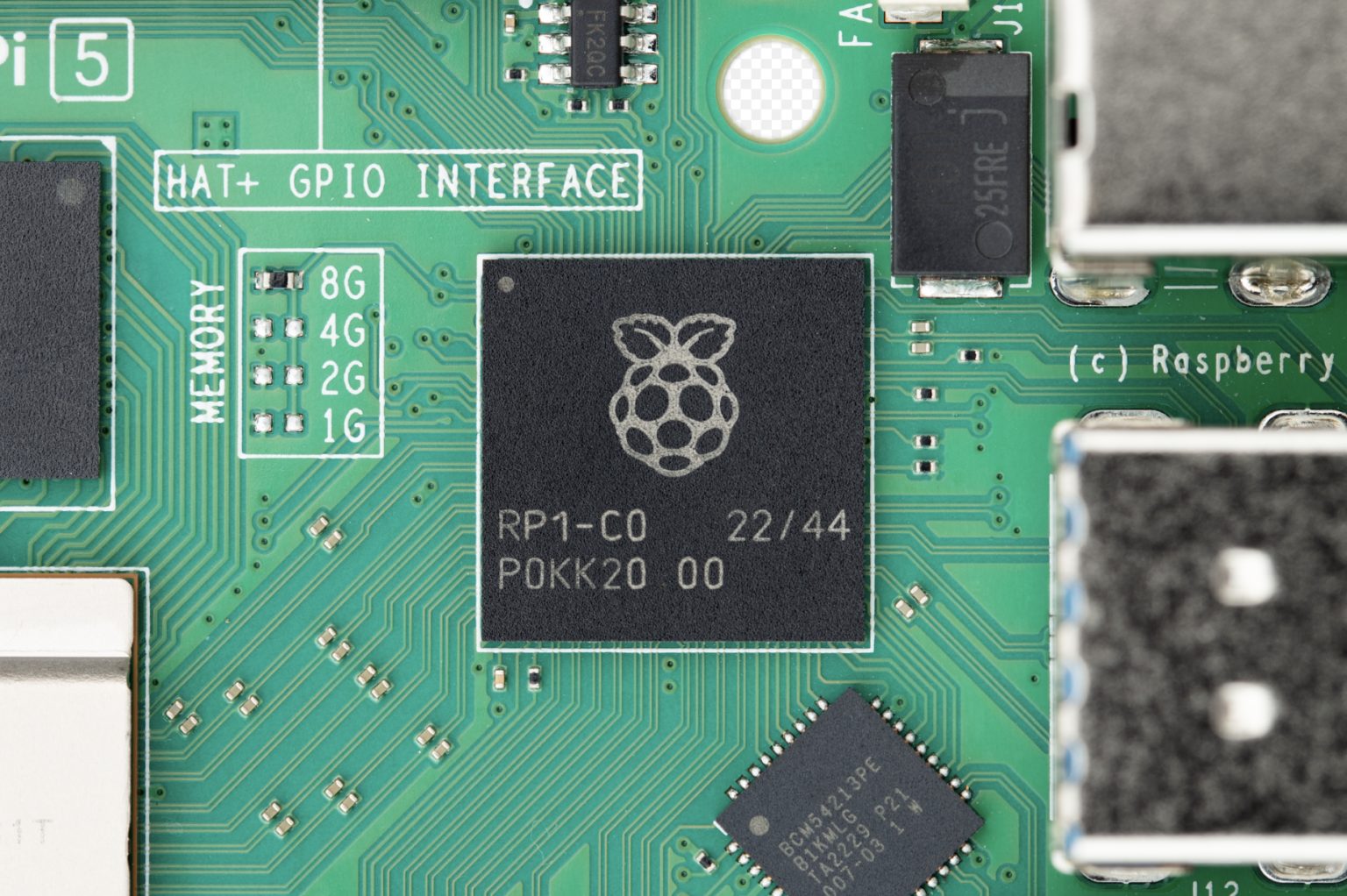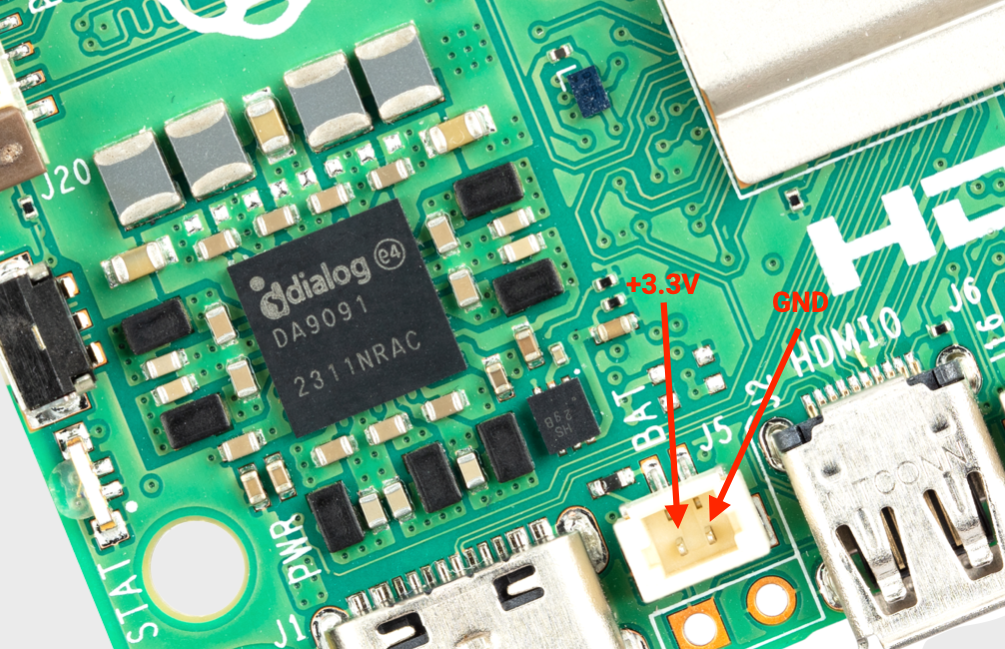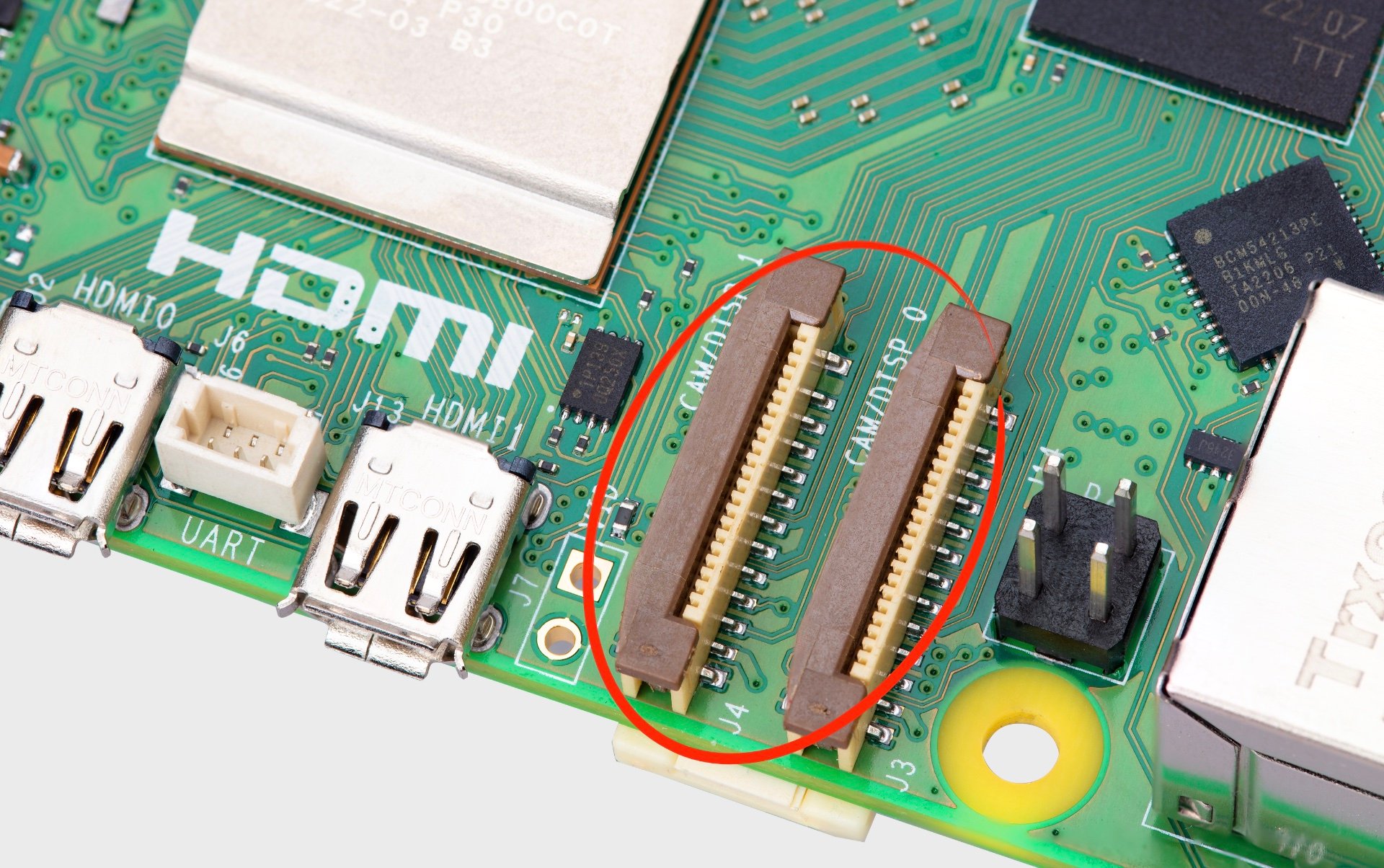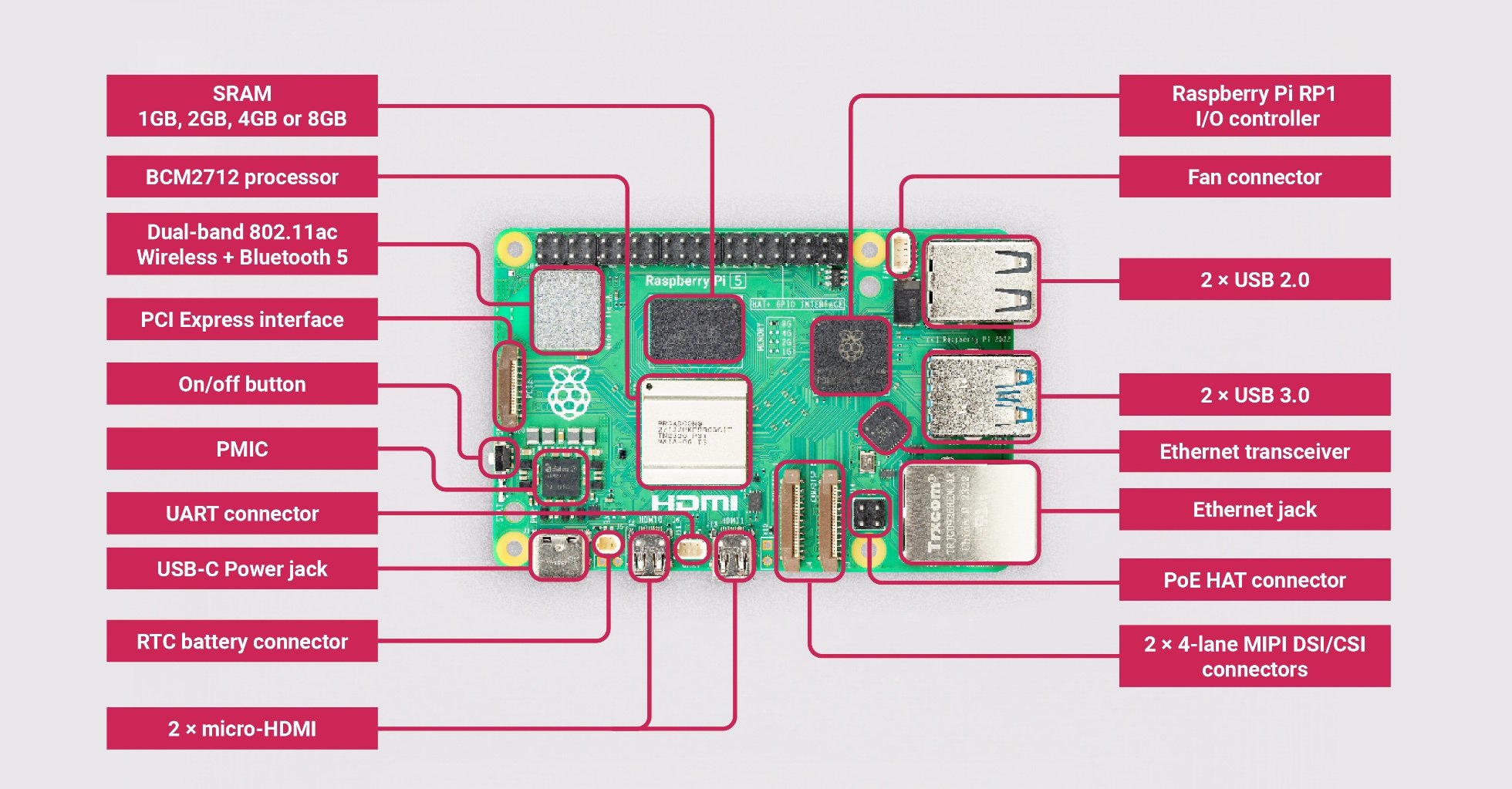Raspberry Pi 5 model B
Designed in Cambridge, manufactured in Wales
Like all flagship Raspberry Pi products, Raspberry Pi 5 is built at the Sony UK Technology Centre in Pencoed, South Wales. The Foundation have been working with Sony since the launch of the first Raspberry Pi computer in 2012.
Priced at $60 for the 4GB variant, and $80 for its 8GB sibling, almost all aspect of the platform has been upgraded.
Key features include:
- 2.4GHz quad-core 64-bit Arm Cortex-A76 CPU
- 800MHz VideoCore VII GPU, supporting OpenGL ES 3.1, Vulkan 1.2
- Dual 4Kp60 HDMI® display output
- 4Kp60 HEVC decoder
- Dual-band 802.11ac Wi-Fi®
- Bluetooth 5.0 / Bluetooth Low Energy (BLE)
- High-speed microSD card interface with SDR104 mode support
- 2 × USB 3.0 ports, supporting simultaneous 5Gbps operation
- 2 × USB 2.0 ports
- Gigabit Ethernet, with PoE+ support (requires separate PoE+ HAT, coming soon)
- 2 × 4-lane MIPI camera/display transceivers
- PCIe 2.0 x1 interface for fast peripherals
- Raspberry Pi standard 40-pin GPIO header
- Real-time clock
- Power button
Three new chips, each designed specifically for the Raspberry Pi 5 program : BCM2712, RP1 and DA9091.
BCM2712
BCM2712 is a new 16-nanometer application processor (AP) from Broadcom, derived from the 28-nanometer BCM2711 AP which powers Raspberry Pi 4, with numerous architectural enhancements. At its heart is a quad-core 64-bit Arm Cortex-A76 processor, clocked at 2.4GHz, with 512KB per-core L2 caches, and a 2MB shared L3 cache. Cortex-A76 is three microarchitectural generations beyond Cortex-A72, and offers both more instructions per clock (IPC) and lower energy per instruction. The combination of a newer core, a higher clock speed, and a smaller process geometry yields a much faster Raspberry Pi, and one that consumes much less power for a given workload.
The newer CPU is complemented by a newer GPU: Broadcom’s VideoCore VII, developed in Cambridge, with fully open source Mesa drivers from Igalia. An updated VideoCore hardware video scaler (HVS) is capable of driving two simultaneous 4Kp60 HDMI displays, up from single 4Kp60 or dual 4Kp30 on Raspberry Pi 4. A 4Kp60 HEVC decoder and a new Image Sensor Pipeline (ISP), both developed at Raspberry Pi, round out the multimedia subsystem. To keep the system supplied with memory bandwidth, we have a 32-bit LPDDR4X SDRAM subsystem, running at 4267MT/s, up from an effective 2000MT/s on Raspberry Pi 4.
RP1
RP1 is the I/O controller for Raspberry Pi 5, designed by the same team at Raspberry Pi that delivered the RP2040 microcontroller, and implemented, like RP2040, on TSMC’s mature 40LP process. It provides two USB 3.0 and two USB 2.0 interfaces; a Gigabit Ethernet controller; two four-lane MIPI transceivers for camera and display; analogue video output; 3.3V general-purpose I/O (GPIO); and the usual collection of GPIO-multiplexed low-speed interfaces (UART, SPI, I2C, I2S, and PWM). A four-lane PCI Express 2.0 interface provides a 16Gb/s link back to BCM2712.
Under development since 2016, RP1 is the longest-running, most complex and, at $25 million, the most expensive program undertaken by the Raspberry Pi Foundation.
RP1 and RP2040 share a certain amount of internal infrastructure, and both were built using the Raspberry in-house SPIV chip-assembly toolchain.

DA9091
BCM2712 and RP1 are supported by the third new component of the chipset, the Renesas DA9091 “Gilmour” power-management IC (PMIC). This integrates eight separate switch-mode power supplies to generate the various voltages required by the board, including a quad-phase core supply, capable of providing 20 amps of current to power the Cortex-A76 cores and other digital logic in BCM2712.
Power Button
The raspberry pi 5 finally offers a PC-style power button, supporting hard and soft power-off and power-on events.
When the Raspberry Pi is plug into power for the first time it will automatically turn on and boot into the operating system without having to push the button.
If you are running the Raspberry Pi Desktop you can initiate a clean shutdown by briefly pressing the power button located on the left-hand side of the board, and then releasing it. This will cause a Desktop menu to appear asking whether you want to Shutdown, Reboot, or Logout. You can select whether you want to shutdown or reboot, or alternatively pressing the power button briefly for a second time will initiate a clean shutdown. Press the power button twice in quick succession to shutdown.
If you are running Raspberry Pi OS Lite in headless mode pressing the power button a single time will initite a shutdown.
To force a hard shutdown: press and hold the Power Button. If the Raspberry Pi board is shutdown, but still powered, pressing the power button will restart the board.
The J2 jumper, located between the RTC battery connector and the board edge, is a breakout allowing to add a custom power button to Raspberry Pi 5 by adding a Normally Open (NO) momentary switch bridging the two pads. Briefly closing this switch will perform the same actions as the onboard power button.
Real Time Clock (RTC)
The Raspberry Pi 5 includes an RTC module. This can be battery powered via the J5 (BAT) connector on the board located to the right of the USB-C power connector. The RTC is still usable even when there is no backup battery attached to the J5 connector.
It is now possible to set a wake alarm which will switch the board to a very low-power state (approximately 3mA). When the alarm time is reached, the board will power back on. This can be useful for periodic jobs like time-lapse imagery.

MIPI CSI/DSI connectors
The CSI and DSI ports found on previous models of Raspberry Pi have been combined into two dual-purpose CSI/DSI (MIPI) ports. To fit onto the board these now use a denser connector pinout, previously only found on Raspberry Pi Zero and the CM4IO board. It's now possible to connect two displays, two cameras, or one camera and one display to these ports.

27W USB-C Power Supply
Raspberry Pi 5 consumes significantly less power, and runs significantly cooler, than Raspberry Pi 4 when running an identical workload. However, the much higher performance ceiling means that for the most intensive workloads, and in particular for pathological “power virus” workloads, peak power consumption increases to around 12W, versus 8W for Raspberry Pi 4.
M.2 HATs
One of the most exciting additions to the Raspberry Pi 5 feature set is the single-lane PCI Express 2.0 interface. Intended to support fast peripherals, it is exposed on a 16-pin, 0.5mm pitch FPC connector on the left-hand side of the board.
Raspberry Pi Beginner’s Guide, 5th Edition
Sporting a brand-new look and feel, and priced at RRP £19.99 ($24.99), the new edition of the bestselling Raspberry Pi Beginner’s Guide is the definitive manual for Raspberry Pi computers and accessories. It has been comprehensively updated to cover Raspberry Pi 5, and the upcoming release of Raspberry Pi OS based on Debian Bookworm.
Raspberry Pi 4 Legacy
Two elements of the chipset have been retained from Raspberry Pi 4:
- The Infineon CYW43455 combo chip provides dual-band 802.11ac Wi-Fi and Bluetooth 5.0 with Bluetooth Low-Energy (BLE); while the chip itself is unchanged, it is provided with a dedicated switched power supply rail for lower power consumption, and is connected to BCM2712 by an upgraded SDIO interface which supports DDR50 mode for higher potential throughput.
- Ethernet connectivity is provided by a Broadcom BCM54213 Gigabit Ethernet PHY
First 45-degree angle
As before, Ethernet connectivity is provided by a Broadcom BCM54213 Gigabit Ethernet PHY; this now sits at a jaunty 45-degree angle, a first for Raspberry Pi, and a source of enduring disappointment for orthogonal-layout enthusiast and CTO (Software) Gordon Hollingworth.
Raspberry Pi OS
In parallel with the final stages of the Raspberry Pi 5 programme, the software team has been developing a new version of Raspberry Pi OS, the official first-party operating system for Raspberry Pi devices. This is based on the most recent release of Debian (and its derivative Raspbian), codenamed “Bookworm”, and incorporates numerous enhancements, notably the transition from X11 to the Wayfire Wayland compositor on Raspberry Pi 4 and 5.

Sources
RP1: the silicon controlling Raspberry Pi 5 I/O, designed here at Raspberry Pi